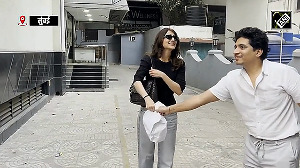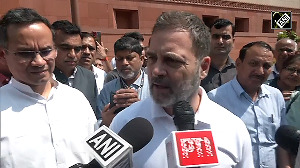'Pandi was promised something, that is not happening, so his anger is not of a villain's.'
'That's how all normal humans would react, or they stay silent.'
'Our violence is our silence. So in this world, everybody is innocent.'

In January 2021, P S Vinothraj premiered his indie Tamil film Koozhangal (Pebbles) at the Rotterdam International Film Festival.
The film stunned the festival's audience and the jury gave it the top Tiger Award.
After traveling to many film festivals, Koozhangal -- the story of a father and his son in search of the boy's mother -- was submitted as India's best international film Oscar entry.
A few weeks ago, Vinothraj premiered his new film, Kottukkaali (The Adamant Girl) at the Berlinale.
Made with the similar independent spirit, Kottukkaalli stars Soori Muthuchamy and Anna Ben.
Like his first film, Kottukkaali is also set in one day. Meena (Ben), a young college student, is engaged to marry Pandi (Muthuchamy).
But she falls in love with another man, who belongs to a lower caste.
Pandi and Meena's families try to convince Meena to change her mind. But when she refuses to marry Pandi, 12 members of the two families travel first to a deity and then to a seer with the hope to change the adamant girl's mind.
On the long journey, with an entourage of three motorcycles, an autorickshaw, and a rooster at the back, the travelers encounter all sorts of events, including a terrifying bull who is blocking the small rural road. All the way, Meena does not speak a word, which irritates Pandi and his family.
Kottukkaali is a prime example of terrific film-making in India. It is gripping and funny, even though it deals with serious subjects like patriarchy and superstition.
In Berlin, Aseem Chhabra spoke to Vinothraj, Muthuchamy and the film's sound designer Suren G about the making of the film.
Vinoth, I loved Koozhangal. It was such a unique and truly independent film. Kottukkaali is even stronger and it is populated with more actors. There were 12 people who go on the journey on the three motorcycles and the auto. I didn't count the rooster. I am curious about why in both the films, the journey and the movement is so important.
Vinothraj: I wanted to show the mob mentality in the film. That's the reason we had such a huge number of people traveling.
I didn't want them to be robotic.
That's how they are, that's their body language.
They would not go separately, they always travel together, like a bunch of people.
And now, they are going to address an issue, so the whole family gets together.
In both my films, the reason behind keeping the characters moving is that's how they function. I wanted to show them as they are.

In Koozhangal, it was just the boy and his father. In Kottukkaali, there must have been a lot of rehearsals, as the camera is behind the characters, in front of them and goes around them.
Vinothraj: Anna and Soori are experienced actors and they know how to handle the camera.
They were not camera conscious.
But the other artists were basically my relatives and friends.
They were first time actors. They had a natural body language. I wanted them to be themselves.
But when you place the camera, they would get camera conscious.
I rehearsed with them for almost seven months. We shot them with small cameras. When I felt that they were getting into acting mode, that they were looking plastic, I would send them off. It was a very long process.
When Soori and Anna joined the shoot, everything was seamless.
You know I have a question about something I didn't understand. Soori's character has a white substance on his neck. Was that for any religious reason?
Vinothraj: The film kind of opens halfway. Before the film starts, there would have been another episode where Pandi's character would have shouted a lot, so his voice was down because of that.
He had developed a throat problem, infection or something like that. This was actually medicine.
They put a paste of limestone powder and sugar, and rub it on his throat and neck.

So that's why throughout the film, he speaks in a hoarse kind of a voice.
Soori, I had seen you in Viduthalai Part 1 last year and you had a regular voice.
In Kottukkaali, was it hard for you to keep the voice down to that level, even when your character is very angry.
Soori: Yes, it was difficult. And this film is shot in sync sound and with a lot of long shots. So I damaged my voice on purpose.
I went to a doctor and took some medicine to damage my voice, so that you won't hear my actual voice.
Soori, I am curious about the role you play because in Viduthalai Part 1 your character was an innocent, committed policeman. I am waiting for part two of the film.
Actors are trained to do whatever is asked of them, but you are so angry in this film. You explode in the middle of the film ,but often, you get angry in a very quiet, seething manner.
I don't know if you have any specific training in doing that or as an actor you just performed what the director told you to do?
Soori: In Viduthalai, I played a different role because I was a lower rank police officer. So I had to respect my upper rank officers. That character was simple.
Kumaresan was an honest person and not ready to budge or say sorry for something that he didn't commit. In this film, it's a different role.
I worked a lot on Vinoth's inputs. Pandi's actions were basically what were written for him.
Pandi was promised something, now, something else is happening. That's why he is disturbed.
That's why there is anger and outburst. Actually, Pandi is not a bad guy.
Yes, in the end, you get a sense that he's not a bad guy. Even throughout the film, there are moments when he apologises for his actions.
Soori: In fact, Pandi is the one who wanted Meena to study. The other sisters wanted her to get married much earlier.

Vinoth, while I know you left the film open-ended, and I don't need an explanation, but the way I see it, I think Pandi has a change of heart at the end.
Vinoth: Yes, I kept it open-ended because I have shown you the world of these people.
Now it's up to the audience to decide.
If you are Pandi and something like this happens in your family, what would you do?
Suren, I wanted to find out from you about the sound recording. While you are in a rural environment with farms around, yet there is a constant sound of the auto and there were three motorcycles. How did you capture all those sounds?
Suren: It was challenging because this is a sync sound film. And predominantly, it is the sound of the auto, the rusty, gritty sound.
But to separate that from people's voices was the challenge.
So we made some arrangements. We took the auto to a workshop to make its sound a little more subtle.
We toned down the engine sound for the shoot, so that we can hear the artists really clearly and crisp.
We also tried to capture the ambience sounds during the shoot.
Whatever you are hear in the film, it is exactly captured on location, on the particular day and time.
Another decision was that we were not going to have a composer for this film.
I didn't realise there is no music in the film.
Suren: I am really happy you didn't miss the score. It was our great achievement.
It is very rare not to have composer in a Tamil film. Vinoth was relaying so much on people's performances.
Whatever the nature offered, we captured those sounds.
For every scene, we would have three to four variations of treatment -- either using lush, green environment sound, or totally tone down with one single ambient sound.
At times, we captured the sound of a particular bird calling the rooster.
When the film starts, Amma walks from her home to the temple early in the morning. We recorded the footsteps which is all you hear in that long take.
The same thing with Pandi's character, when he approaches another character and it is from his POV. You only hear his footsteps that makes you believe that he is present.
In the bull scene, everyone is trying to get away from the bull.
One guy calls another man who lives in the hut. We still haven't seen the girl who the bull is close to, so we were waiting on the screen.
To increase the tension, we hear the rustling of the coconut trees.

Vinoth, Suren mentioned two things. First of all, how do you train the bull? It looked so frightening initially. But when the little girl appears, the bull just calmly follows her.
The other thing I loved about the film was the rooster and the little boy. Those were the two innocent people.
What were your thoughts on that? I suppose you would have to wait for the rooster to look at the camera to get those shots.
Vinoth: About the bull, I wanted an animal that was treated as a family member. So there should be a small girl and the family should treat the bull as its own.
We searched for people and finally found a father, his daughter and the bull.
But the challenge was that the bull was comfortable with the girl, but the family had to be shifted away from their own home.
The family was brought to the location where the film would be shot. So in that case, when the bull comes to a new place, it is uncertain about the location.
The family left the bull there for three to four days, so it could you get used to the terrain, have the chance to smell the new land.
What about the young child?
Vinoth: The small boy was a reflection of Pandi when he was a kid. He was happy and funny, like a normal kid. But the society has changed Pandi to what he has become.
The responsibilities he has been given and all that is being fed to him. The little girl, who drags the bull, is a younger version of Meena.
Meena was a queen and very confident. Pandi was the name of the king of Madurai.
When you give a child that name, what kind of a future do you expect him to have?
The entire film is a war between King Pandi and Queen Meena.
Also, the family is all innocent. There is no negative shade. The entire family has been brought been up under existing social and cultural circumstances.
Pandi was promised something, that is not happening, so his anger is not of a villain's.
That's how all normal humans would react, or they stay silent.
Our violence is our silence. So in this world, everybody is innocent.












 © 2025
© 2025